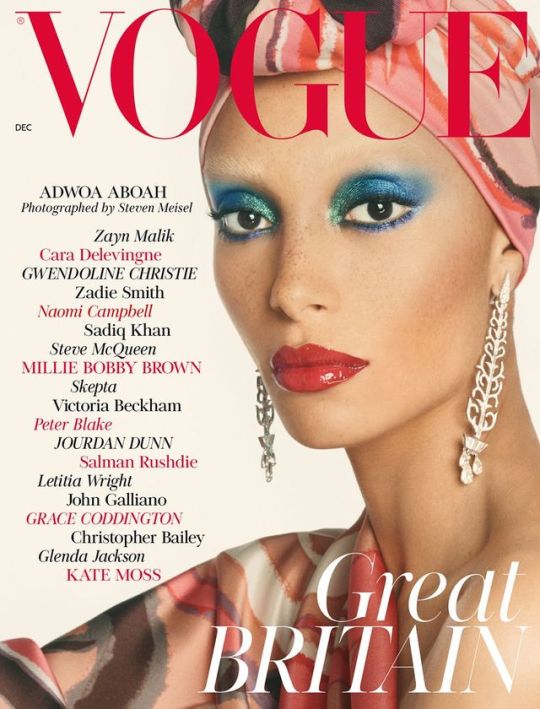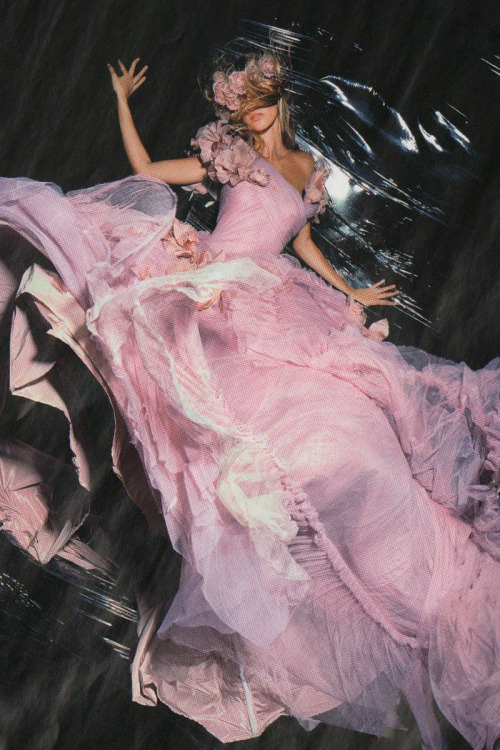emilywilkinsonfcnu-blog
66 posts
18 | Fashion Communication @ Northumbria University
Don't wanna be here? Send us removal request.
Photo

Maternity dress and coat. Vogue Pattern number 9510, 1960s. (x)
223 notes
·
View notes
Photo

Adwoa Aboah wearing Marc Jacobs Spring ‘18 on the cover of Edward Enninful’s first edition of British Vogue ✨ Photographed by Steven Meisel
1K notes
·
View notes
Photo

Lana Del Rey is the Dazed magazine Spring/Summer cover star, interviewed by Courtney Love and photographed by Charlotte Wales 📸 Out everywhere 4/20
639 notes
·
View notes
Text
Traditional VS New Media: Could Magazines Become a Thing of the Past?
Out with the old, in with the new.
After reading an article recently written by The Guardian commenting on Conde Nast’s President Chief in regards to his lack of fear around the fate of print media, a serious question must be addressed as to whether magazine publications do have a future or not.
For years, magazines has suffered as technology only keeps rising and the digital era places immense pressure on traditional media. With well-known magazine conglomerates choosing to go online-only, including The Independent, the denial of magazine publications seemingly continues to grow.
Yet, Conde Nast’s International President Chief Nicholas Coleridge claimed that, “Magazines are defying digital erosion” in contrast to a monthly sale of 135,000 copies a month in 1989, Vogue now, in present day, gains around 200,000 monthly sales on their magazines. Coleridge states that consumers find that there is “something alluring about a glossy magazine, the physical quality, particularly a very thick one” seemingly a magazine is more of a personal possession, whereas digital publications are something everyone accesses.
Furthermore, it could be argued that without magazine publications we blur the divide between professionalism and citizen journalism. Coleridge suggests, “A good editor makes sure everything in a magazine has a coherence of tone, appearance and attitude” meanwhile bloggers can be any individual of any age or (lack of) background who may only have a vague understanding of fashion history. Lorraine Candy, former editor-in-chief of Elle UK, incoming Sunday Times luxury content editor states, “There is enough evidence to prove that there will be print, and it will continue to be in many forms and be available in many places.”
So what does the future of publishing look like?
Whilst our world is ever-changing and companies certainly aggregate online content such as social media platforms like Facebook or Instagram, the belief that magazine publications are becoming a thing of the past maybe be merely a myth. Although brands are reluctant to work with new media such as bloggers and using digital media as a way of attracting and broadening their audience, companies are adapting to the new world as technologies advantages are both extending and expanding brands. This doesn’t mean that companies must turn their back on print media, but continue to grow and take full advantage of new media as a way of developing their brand.
0 notes
Photo

Céline Fall 2017 Ready-to-wear
150 notes
·
View notes
Text
The Evolution and Manufacturing of Wool
Wool is a huge part of Britain’s history and heritage. It is said to have been around since 4th millennium BC with the oldest known European wool textile being 1500 BC. Before the invention of shears, wool would have been plucked out by hand or by bronze combs.
Considered the driving force of the medieval English between the late 13th century and the late 15th century, it was described as “the jewel in the realm”.
The peak of wool production was during the thirteenth century, but wool trade declined due to political strife. In 1331 King Edward the 3rd encouraged Flemish masters to settle in England meaning that these descendants play a part in the final ascendancy of English cloth.
By the mid-fourteenth century English wool farmers flourished and despite the long war with France, raw wool exporting and manufacturing of the material expanded. The west of the country was at an advantage due to it’s sheep and the supply of soft water for watering power, dyeing and scouring to help drive milling machinery. The Pennine districts of Yorkshire and Lancashire also had soft water, and water power from steeply graded streams.
At the end of the fifteenth century England was `largely a nation of sheep farmers and cloth manufacturers' with the following two centuries resulting in further expansion of the industry.
The Industrial Revolution of 1750-1850 caused upheaval due to inventions which mechanised and sped up the process of spinning and weaving. The machinery won the day as it meant more in terms of manufacturing, processing and supplying, despite risking the future of employment for workers. The revolution saw the introductory of other fabrics such as Tweed in Scotland.
The skill of British breeders has had widespread effect ever since it first began. The eighteenth century saw a further peak in manufacturing when the great Robert Bakewell of Leicestershire pioneered new techniques.
1. Improve the natural coat of the sheep
2. Use the coat of early sheep astray grow both coarse and fine wool in the same fleece
Flocks can be grouped into three main groups-short-wool and down; longwool and lustre; and mountain and hill. In terms of manufacturing, wool cloth is either wooden or worsted.
Despite the demands of meat trade, the British wool is, in fact, better than it has ever been. One-third and one-half of the home wool clip is exported annually. There are about 90,000 wool producers in the United Kingdom producing nearly 40 million kg of fleece wool a year.
0 notes
Video
vimeo
This is my new favorite thing
23 notes
·
View notes
Photo


Anatomy of Change
Thierry Mugler | Men’s Fall/Winter 2011 (ft. Rick Genest)
4K notes
·
View notes
Photo




Gareth Pugh Spring / Summer 2018
639 notes
·
View notes
Photo

Nick Knight for Alexander McQueen 1997
2K notes
·
View notes
Photo

“Knight Vision” Gisele Bündchen by Nick Knight, Vogue UK November 2006
5K notes
·
View notes
Text
From Fashion Photography to Fashion Film: the Importance of Capturing Garments
From Photo Journalism to Fashion Film. Capturing the mood or nowadays, the movement of clothing is an important marketing technique so that consumers get a better understanding of what the garments will look like when worn.
What would be the point in apps such as Misguided or websites like Debenhams if we had no photo of the model wearing the items? Instagram, a photo based social media platform, reached 800 million monthly active users in September 2017.
The first camera was made in 1816 by Nicéphore Niépce. The small camera was assembled by a piece of paper coated with silver chloride, which darkened when it was exposed to light. At first cameras were typically used for portraits, but by the first decade of the 20th century halftone printing allowed for fashion photographers to capture the glamour, rebellion and art of the era which began to be published in magazines.
1910 - 1934: Edward Steichen for Condé Nast
Steichen was described as the ‘father of modern fashion photography’. He set the boundaries of making fashion a fine art. He did this by shooting an array of outfits by French fashion designer Paul Poiret which were published in the April issue of ‘Art et Decoration’ in 1911. This was the first ever photography shoot for a magazine and the birth of fashion photography as an art form.
1944 – 1960: Avedon and The Great Outdoors
Richard Avedon was a young budding advertising photographer who was a student at Brodovitch’s “The Design Laboratory” course at the Pennsylvania Museum School of Industrial Art. In 1946 Brodovitch, who recognised Avedon’s talent in photography, sent him to Paris to cover the latest collections from the premiere fashion houses. Replacing rather lifeless images from the Steichen era, Avedon’s talent encapsulated vitality and vibrance. His work provided the edge Harper’s Bazaar magazine needed securing the publication with a promising future.
1970 – 1980: Pushing the Boundaries, the Rise of Sexual Controversy
The 70s welcomed back the studio setting with open arms. The movement was pivotal as it explored female unity and surrealism. Richard Avedon could be described as the leader of this movement as a lot of his work during this decade celebrated confident female sexuality, specifically through his shots for Versace.
200s: Hypersexuality and Commercialism:
‘sex sells’. The noughties defined the age of hyper sexuality, one brand in particular unafraid of showing off skin was Tom Ford through his advertisement of his first fragrance for men in 2007.
Another rise through the era was celebrity endorsement. Brands such as Marc Jacobs featured Miley Cyrus and Lady Gaga for versace.
21st Century moving forward:
Nowadays fashion film is particularly prominent as it captures the movement of an individual within the garment. Famous fashion filmmakers include Nick Knight, Harley Weir and Gareth Pugh. A lot of fashion film is experiential and has a meaning behind it. It is artistic and expressive.
Fashion photography is highly recognised and celebrated within contemporary society, being rightfully described as a creative art form a label which photographers throughout the decades worked hard to create.
In an interview with Nick Knight, Lara Johnson Wheeler finds out the filmmakers views on the future of fashion film and its growing importance as a medium,“Fashion film isn’t like ordinary film, and shouldn’t look to those references; it should be more akin to fashion photography. Fashion film is just moving fashion photography, it’s garments in movement. The medium is non-narrative.”
0 notes
Photo

D.ISTINTO - FASHION ADVISE
ECOALF, the Spanish company that transforms the garbage, found in the Mediterranean Sea, into clothings. This is great.
This is the future of fashion, conciousness and sustainability. This should be the future of the world!
https://www.instagram.com/ecoalf/
218 notes
·
View notes



